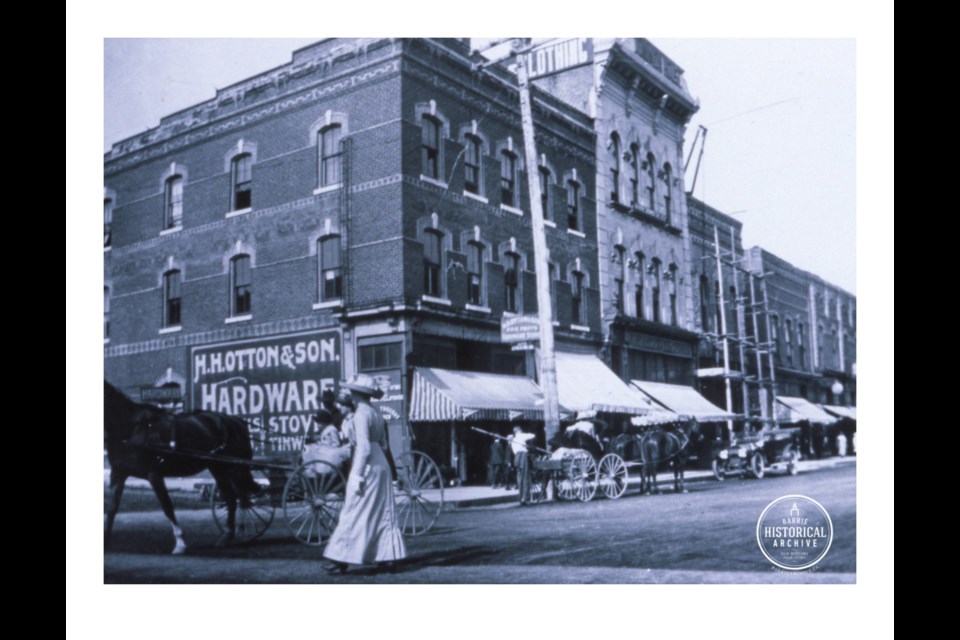My workplace is on Bayfield Street, about as far south as you can go without getting wet. On Friday afternoon, after parking my car in a lot, I could hear some sort of commotion nearby. As I approached the Dunlop Street intersection, I found the source of the raised voices. Here was a young couple having a domestic altercation right in the dead centre of Five Points!
By the time I arrived, bystanders or friends had pulled the dueling pair apart and were attempting to drag them even farther away from each other. Fists were still vainly swinging, and the finest of the English language was being hurled about. A few onlookers bellowed out a few useful opinions of their own.
I thought to myself – this is certainly not the first time that the front step of the old Simcoe Hotel has borne witness to loud exchanges, disputes, brawls, and other assorted raucous events.
No siree, the grand old lady Simcoe is not likely to blush at anything she sees! In her 160 years, many theatrics have played out just beyond Simcoe’s front door. Lumbermen, lake traders, sporting teams, farmers and assorted travelers came with money to spend. They came looking for a good time, to let their hair down for while and forget that life could be hard and short.
What often began with a bit of good fun at a local watering hole, often ended with the making of acquaintance with a stern-faced police officer and a trip to the castle on the hill.
Queen Victoria’s May birthday was always a big cause for celebration well over a century ago, as if the local folks needed a reason to hoist a few pints, and a great day of games, sporting competitions, picnics and music was held to mark the day. In 1890, the inevitable hijinks that followed were quickly blamed on visitors from out of town who had arrived on three trains and a lake steamer. These visiting revelers were said to have been “bent on getting as much whisky as they could carry,” which must have pleased at least the publicans of Barrie.
The Northern Advance of May 29, 1890 reported that “the pleasures of the day were greatly marred by drinking and rowdyism on the part of a good many who came from Toronto. What with obscene and blasphemous language, brawls and fights for some time, that part of the town near the Points seemed like pandemonium let loose. Young lads were staggering around the streets so intoxicated as to be almost helpless. Such an exhibition is most discreditable to all concerned.”
This was nothing new. For decades, the expectation was that things would more than likely get a little rough downtown on a weekend night, and that people who were averse to drunkenness and random outbreaks of fisticuffs might want to stay clear.
The editor of the Northern Advance tucked a public nudge to the town fathers into his Local Items section of the paper on April 8, 1875.
“Fighting at the ‘Five Points’ – This locality has become quite notorious for the toughs that do congregate. Last Saturday, there was more fighting there. The constable arrested some of them, and His Worship sentenced one of them to a fine or as a default, a short stay with Mr. Lang (jailer). I hope His Worship will, in future, deal severely with these disturbers of the peace brought before him so as to ‘stamp out’ these disgraceful brawls.”
One exceptionally sad tale, that really serves to highlight the dangers of excessive imbibing out on the streets in those saloon town days, is that of a woman named Elizabeth Meyer. Her tragic story still gets passed around as her name has been given to the ghost that some have claimed to have seen just inside the Simcoe Hotel.
Elizabeth Meyer was said to have been a married woman of about 35 years of age, who fell on hard times and took to drink. On an extremely cold night in January of 1872, she was found dead, or nearly so, on the front step of the hotel. She was brought inside and laid out on the floor, and the doctor called, but the poor woman never regained consciousness.
The coroner, Dr. Crookshank, immediately made an inquest and found that she had been quite under the influence of alcohol, and had received some serious injuries just prior to her death. Had she fallen or was she attacked by some other person? The jury returned a verdict in the cause of Elizabeth Meyer’s – “Death from intemperance, exposure to cold, and certain injuries which there is no evidence to show how received.”
Some interesting reading is to be found in the quarterly Schedule Return of Convictions for the County of Simcoe published in the local newspapers during the 1800s. This handy laundry list of what your neighbours have been up to included the name of the offender and of the person pressing the charge, date of conviction, judge, penalty, to whom any fines were paid and when, and any other observations regarding the case.
The session ending Sept. 15, 1879, as an example, included 112 convictions. If all cases involving alcohol or fighting were removed, only 25 would remain.
It may be that those old Hollywood western movies, rather than being sensationalized for the screen, were possibly pretty tame compared to an old time Barrie Saturday night!
Each week, the Barrie Historical Archive provides BarrieToday readers with a glimpse of the city’s past. This unique column features photos and stories from years gone by and is sure to appeal to the historian in each of us.



